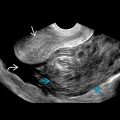KEY FACTS
Terminology
- •
Primary: Involvement of kidneys without evidence of other organ or nodal involvement; extremely rare: < 1%
- •
Secondary: Dissemination of extrarenal lymphoma; more common
Imaging
- •
Multiple hypoenhancing/hypoechoic masses; may see posterior acoustic enhancement from “pseudocystic” nature
- •
Direct extension from retroperitoneal adenopathy, associated hydronephrosis
- •
Solitary hypoenhancing/hypoechoic mass
- •
Bilateral renal enlargement
- •
Perinephric disease
- •
Vascular invasion rare
- •
Multisystem involvement, such as liver, lung, CNS, bone marrow, and gastrointestinal tract
Top Differential Diagnoses
- •
Renal cell carcinoma
- •
Transitional cell carcinoma
- •
Metastases
Pathology
- •
Primary: Involvement of kidneys only
- •
Secondary: Dissemination of extrarenal lymphoma by hematogenous spread (90%) or direct extension via retroperitoneal lymphatic channels
- •
Usually non-Hodgkin lymphoma, typically B-cell or Burkitt type; involvement by Hodgkin disease very rare
Clinical Issues
- •
Any age (middle aged to elderly more common)
- •
Symptoms related to extent of lymphoma, diffuse tumor may cause functional renal impairment
- •
Other complications: Renal or perinephric hemorrhage, renal obstruction, renovascular hypertension
- •
Image-guided biopsy important to differentiate from other solid renal masses and determine medical or surgical management
- •
Immunocompromised (postorgan transplantation, HIV), prior treatment for malignancy, autoimmune disorders, viruses, such as Epstein-Barr
Diagnostic Checklist
- •
Consider clinical history, presence of another malignancy, extent of disease
Scanning Tips
- •
Look for extrarenal nodal and other organ disease
- •
Optimize color sensitivity to detect flow in markedly hypoechoic masses










